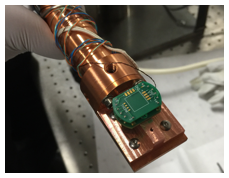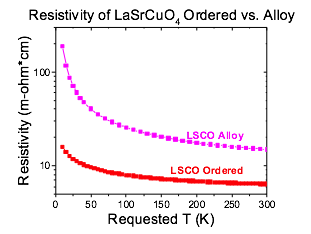Reports: UNI1055121-UNI10: Engineering Superior Oxide Catalysts via Electrostatic Strain
Brittany B. Nelson-Cheeseman, PhD, University of St. Thomas
Major Goals
The overarching goal of this project is to realize material design strategies that increase the activity of transition metal oxides (TMO) in order to increase the efficiency of petroleum-relevant catalytic processes in applications such as solid oxide fuel cells. In particular, this project focuses on advancing a method of custom atomic ordering in known layered transition metal oxides that alters the local structure and bonding, resulting in improved catalytic materials properties. This project also contributes to the interdisciplinary training of undergraduates in a variety of settings, and exposes them to research in petroleum-relevant fields.
Accomplishments Towards These Goals
The PI and six undergraduate students have grown and characterized over 20 thin films at the University of Minnesota (UMN), Argonne National Laboratory (ANL), and the University of St. Thomas. A custom Janis electrical transport system has been successfully setup at UST for electrical transport measurements (Figure 1).
Figure 1. Custom cold finger for Janis electrical transport system at UST.
The group was able to successfully grow and characterize the structure and transport of La2-xSrxCuO4 epitaxial films (x=0-1) (Figure 2), and is finalizing a manuscript for submission as a peer-reviewed journal article. The supported work found that increasing the Sr content from x=0 to x=1.0 causes a peak in the c-axis lattice parameter (Figure 3) and the roughness values near x=0.50 (Figure 4). The films were smooth and crystalline, exhibiting similar electric properties as are found in bulk samples (Figure 5). The ability to create ultrathin films at high Sr levels shows promise for the potential of inducing novel electric properties through cation ordering and interfacial effects.
Figure 2. X-ray diffraction of epitaxial La2-xSrxCuO4 films on LaSrAlO4(001).
Figure 3. C-axis lattice parameter of film from X-ray diffraction as a function of Sr content.
Figure 4. RMS surface roughness as a function of Sr content.
Figure 5. Electrical resistivity as a function of temperature for La2-xSrxCuO4 films.
This success with growing the LSCO random alloy films has allowed the group to begin growing the desired ordered variants. Preliminary results demonstrate a marked difference in electrical resistivity between the ordered and random alloy LSCO (x=1) samples (Figure 6).
Figure 6. Electrical resistivity as a function of temperature for LSCO (x=1) alloy and ordered films.
The group has also attempted growths of LaBaNiO4 (at ANL) and LaBaCuO4 (at UMN), but is still working to successfully stabilize these films with high crystallinity and low surface roughness.
Opportunities for Training and Professional Development Provided by This Grant
This project has provided six mechanical engineering undergraduate students from the University of St. Thomas (UST) with extensive experimental training not normally found at the undergraduate level. This includes being trained to operate, collect and analyze data from molecular beam epitaxy (MBE), reflective high energy electron diffraction (RHEED), X-ray diffraction (XRD), X-ray reflectivity (XRR), Atomic Force Microscopy (AFM), metal DC sputtering, and electrical resistivity measurements (4-point and Van der Pauw) as a function of temperature. Additionally, the students constructed and optimized the custom electrical transport system used for their electrical transport measurements (Figure 1). The students have performed these experiments in a variety of locales, which exposes them to the diversity of settings in which research is conducted. These locales include an undergraduate lab at their home RUI institution (UST), a graduate lab at an R1 institution (UMN, Dept of Physics), and two shared facilities labsÑone at an R1 institution (UMN, Characterization Facility) and one at a national laboratory (ANL, Center for Nanoscale Materials). In addition to lab training, the students have also practiced how to communicate their progress and results through creating and presenting posters at local ('Inquiry at UST') and national venues (American Physical Society March Mtg, Baltimore, MD), as well as working to develop two technical manuscripts for peer-reviewed journal articles. Through this program, the PI has gained significant training and professional development in how to manage the activities, budget, and reporting for an external grant. In particular, she has learned how one can be resourceful and move a program forward in the face of setbacks or obstacles that deter the original proposed plan.
Changes to Approach and Reasons for Change
This program has had some significant infrastructure setbacks. In particular, the program has had to deal with significant down time of the MBE growth facilities at both the UMN and ANL. Most importantly, the UMN growth facilities are currently only able to grow with La and Cu. In response to the available resources, the program has currently pivoted to investigating La,Cu-heterostructures that still focus on altering the local structure and bonding to achieve enhanced properties for fuel cell cathode materials. In particular, the 3D perovskite LaCuO3- d (LCO113) and the 2D layered perovskite La2CuO4+d(LCO214) are both simultaneous electronic and ionic conductors of interest for fuel cell cathode applications similar to the original proposed work. While each material has complementary benefits and drawbacks for oxygen ion incorporation and diffusivity, a combination of the two materials may mitigate these drawbacks, while enhancing the total benefits. Unexpected emergent effects may also present themselves. Thus, the group is now pursuing investigations of how the electrical properties are modified when LCO113 and LCO214 are brought together in epitaxial layered heterostructures. Both single films have been successfully grown, and analysis of a bilayer film and what occurs at the interface between the two materials has begun. In the coming reporting period, the growth, structure, and electrical properties of more complex layered heterostructures will be investigated.
Plan for Next Reporting Period
The program will continue to grow more films, and characterize the structure and electrical properties. If growth with aliovalent cations continues to be inaccessible, the group will focus on investigations of the LCO 113/214 structures. The group plans to submit at least two papers for publication based off the work supported by this grant. The program will continue to provide training and professional development for undergraduate students. Additionally, the students will gain experience with the peer-review process for journal article submission, review, and publication.

















